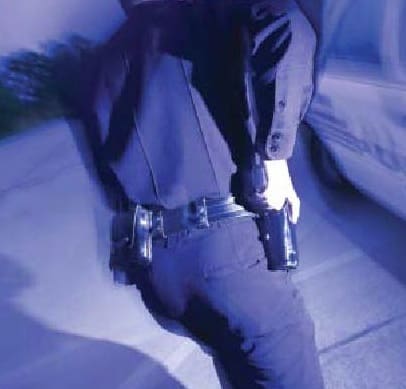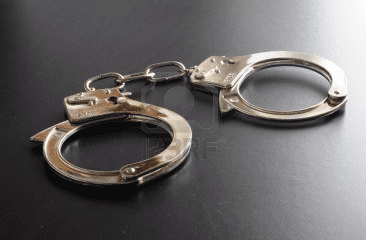[The following account was written by Dan Brooks, member of the Virginia Citizens Defense League. It’s republished here with the VCDL’s permission.]
I have only had one loaded gun pointed at me in my entire life where the gun’s owner was prepared to use the weapon on me. In that encounter, I learned a great deal about the mindset of police officers when circumstances are ambiguous and a gun is present, but not in the control of an officer. Needless to say, I survived to tell the tale, but it could easily have gone any number of other ways . . .
The incident occurred at about 4:00 am in a local convenience store. I had just gotten off of a 20 hour day at work and was stopping in for a snack before going home to bed. At the time, I was carrying my pistol concealed in a holster on my right hip. Concealment was provided by a jacket that was just long enough to cover my pistol completely when standing or walking. I entered the store and proceeded down the chip aisle to make my selection and then over to the drink machine which was on the wall opposite the entry door. When entering, I noticed that I was the only customer in the store.
It is my normal practice, when visiting convenience stores, to maintain visual and auditory situational awareness. I keep track of comings and goings and where others are in the store. I was not doing this during the visit that night, as I was very tired and just wanted to be home in bed. As I was filling a drink cup, I failed to notice that another customer had entered the store. As I reached for a lid high on the machine, I heard the sound of a semi-automatic pistol being charged a few feet behind me and a shout of “City Police! Keep your hands where I can see them!”
Needless to say, I was instantly on alert and afraid that something bad was about to happen. I instantly made the decision that probably saved my life that night. I froze rock steady, then while saying “Certainly Officer. How do you want to proceed?” I very slowly extended my arms, drink, lid and all, to about 10:30 and 1:30. I had two intentions in so doing: a) to let the Officer know that I had heard her command and b) to let her know that she was in total control of the situation. I did not attempt to explain the presence of my gun. I did not set down the things in my hands. I complied instantly and fully with the Officer’s command.
The Officer then said “You have a concealed handgun! Do you have a permit for that?”
I replied in a loud, clear voice, “I have a concealed handgun permit in my wallet, which is in my right hip pocket.”
“Take it out!”
“How do you want me to take my wallet out?”
“Slowly!” was all the instruction I got.
Knowing that this is almost always the point at which someone will get shot by an Officer, I announced that I would drop the lid in my right hand and move the drink to my right hand over my head. When that was complete, I would reach behind my back and remove my wallet with two fingers of my left hand. I then waited for her thoughts on my plan. I did not immediately begin to perform the actions in the manner that I stated that I would.
Only after the Officer said “Okay.” did I begin to perform my actions exactly as stated. I dropped the lid in my right hand and slowly raised my right hand to vertical after the lid stopped moving. I moved my left hand with the drink up to vertical and put the drink in my right hand. Leaving the left hand aloft over my head, I lowered my right hand, and the drink, to it’s former location at 1:30.
Once I stopped moving my right hand, I paused to give the Officer a moment to assess and shift her attention to my left hand. I slowly moved my left arm, fully extended down and behind my body to 6:00. With my hand as far away from my body as I could manage, I then bent my elbow so that my hand was near my pocket and announced loudly “I’m going to remove my wallet now with two fingers!” I waited for a reply from the Officer, but none came.
I pressed on. I slowly pushed my thumb and index finger into my pocket and, with all of my left fingers fully extended, carefully and slowly wiggled out my wallet. I did not then turn around and begin rummaging in my wallet and explaining that I was “legal.” Instead, I moved my left arm very slowly back to it’s original extended position at 10:30, whereupon I asked loudly “How do you wish for me to proceed, Officer?”
The Officer replied that I should “Turn around and show her my permit and ID.” This left me in a bit of a quandary, as I would need to use both hands to get my CWP and ID out of the wallet. I stated so clearly and loudly, without moving. She instructed me to place the drink on the counter. I chose to place it, instead on a display rack to my right that would not require me to move my right hand nearly as much. Moving only one limb at a time, I did so.
I announced that I was turning around and, again moving one limb at a time, did so. I finally got to see the Officer and her gun for the first time. The gun was pointed at my center mass at a distance of about six feet. I took a moment to note that it was a S & W model I was unfamiliar with, as apparently this Officer was issued a Smith with a bore of approximately 2″ diameter. [PVC: I’m surprised it only looked 2 inches in diameter and not like a howitzer!]
I stated clearly that I would now remove my ID and permit. I moved only one hand at a time, and with my hands at chest level and elbows out, I removed my documents from my wallet. I then slowly extended my left hand, with the wallet back to 10:30. I then extremely slowly extended my right hand with the ID and permit directly forward and fanned the items so that she could see the permit clearly.
At this point, the Officer told me to relax and asked if I minded if she ran my permit to make sure everything was okay. I agreed. While she ran the permit, I kept both hands clasped in front of me and in plain sight. I made no effort to put my wallet away or move around. Once the permit and ID came back valid and clean, we had a nice little chat about my carry piece, a Sig, and why she drew on me. As it turns out, she saw my gun as my jacket rode up while I reached for the lid and was unsure whether I was a drug dealer or an undercover LEO. Admittedly, I did look pretty scruffy at the time.
I know that this is a long tale for an event that took a bit over a minute, but I told it this way for a reason. When you are held at gunpoint by an Officer, or otherwise interacting with an Officer in their official capacity, YOU ARE NOT THE ONLY ONE IN FEAR OF LOSING YOUR LIFE! The Officer has that same fear. In all dealings with Law Enforcement, whether you are armed or not, your first thought should be what you can do, or NOT do, to let that Officer know that they see in total control of the situation, and that you are not, and will not become, a threat to their safety.
Always do what the Officer orders you to do. If the command requires that you move, do so slowly, never moving your hands closer to your body unless commanded to do so. Whenever possible, announce that you have heard and understood the Officers commands. Never give the Officer more than one thing to pay attention to. Talk, then pause, then act as directed by the Officer.
If the Officer wishes to disarm you, comply. This not the time or the forum to debate civil rights. Your first responsibility is to do all you can to reduce the threat you are to that Officer. Once the Officer feels safe, the encounter can proceed without the threat of violence. Your second responsibility is to protect your civil rights. Always be respectful, but if you choose not to cooperate with the Officer by answering questions, ask for a lawyer and then do as the Officer directs.
Additional notes:
1) When people experience fear, they react rather than think. Either training or basic survival instinct will take over and bad things will happen.
2) Both the citizen and the Officer experience fear during any contact that even remotely involves a weapon that the other controls.
3) The citizen has the responsibility of defusing the situation, as only the citizen knows he has no intention of harming the Officer.
4) The way to defuse the situation is to comply with the Officer’s commands in a slow, deliberate manner.
Specifically, the citizen should apply ICE to cool the situation down. ICE stands for Inform, Communicate and Execute. (That’s original, but you can use it.)
INFORM the Officer that you understand and will comply with the command he/she has given you.
COMMUNICATE what movements you will make, if any, in great detail. Wait for the Officer’s approval before proceeding.
EXECUTE the movements slowly by moving only one limb at a time.
If you find that you are physically unable to comply exactly as you COMMUNICATED that you would, stop and reapply ICE. Inform the Officer that the planned actions must be changed. Communicate with the Officer what the new movements will be and wait for approval. Execute the movements exactly as you said you would. Never deviate from doing only and exactly what you said you would.
5) Any required movement on the citizen’s part should involve only one moving object at a time. If you must drop something, apply ICE and wait until the object has stopped moving and has been identified by the Officer before proceeding. If you must physically move your body to comply, move only one limb at a time. The only motion that should involve more than one limb moving at a time is to extend your arms slowly and fully away from your body slightly above shoulder height. Do this immediately, but very slowly, while Informing the Officer that you understand and will comply with his/her initial commands.
‘Above all, NEVER MOVE A HAND TOWARDS YOUR BODY OR ANY OTHER OBJECT WITHOUT SPECIFICALLY BEING ORDERED TO DO SO BY THE OFFICER! Apply ICE, over and over, until the threat level reaches green for all parties.
Do not attempt to explain that you are carrying legally. Do not assert that you are not breaking the law. Do not try to talk yourself out of the situation. Do not try to verbally express that you mean the Officer no harm. Complying with the Officer’s commands immediately, but slowly as described, is the fastest way to diffuse the elements of fear and loss of control, and is the only way that you can effectively communicate that you are law-abiding and intend to do no harm.





Great advice!
Thanks for posting that wonderfully written account. For me this story illustrates perfectly one of the major problems with concealed carry. The chances of a cop mistaking you for a criminal is much higher than the chances of you ever needing that gun to protect yourself. Add to that the possibility of theft and other mishaps, and you've got a really bad deal going on.
Of course some folks have a real need to carry a gun, depending on where you live or where your work takes you. But for the average joe, it's a big mistake.
mikeb302000 – I think you are making some gross assumptions in your reply. While this article does show a potential problem with concealed carry (or open carry for that matter), it certainly does not validate your claim that concealed carry weapons are a "problem". In reality, this is a one-in-a-million (probably higher) scenario where the CCW holder acted responsibly and intelligently.
In AZ alone, there are +185k CCW permits. I have yet to hear of any recent incidents, either on the local or national news, news blogs, or firearm community about a similar event. I have had police encounters (not bad ones!) while carrying CCW and the only person who knew about it was me. In a recent situation, I was hit by a drunk driver. The drunk driver in this situation wanted to blow the situation off and I refused (he had caused damage to my vehicle). The driver then became aggressive and aggravated. When the cops finally showed up, only after getting my official statement did anyone ask me if I had a weapon. I answered "of course", showed my permit and where my weapon was secured, and went about the rest of my evening.
Possibility of theft or other mishaps? Really bad deal? Have a real need to carry a gun? Instead of questioning the CCW holder, or the idea of concealed carry, we should be questioning the officer who pulled a gun on a person who was posing ZERO threat. I know quite a few officers and LEO trainers, and I bet ALL of them would agree with me that the female officer in question certainly did NOT act appropriately. Not only was the CCW holder not posing a threat, but the officer was alone and had no backup with her. To bring a situation to that level, without backup, probable cause, or clear-and-present danger was unacceptable. I hope that this officer was reprimanded and her training/tactics reviewed. If it had happened to me, I certainly would want to see some disciplinary action taken against her. Not out of punishment, but rather for the safety of her and others who may have not acted so smoothly in this situation. By not giving clear and concise instructions to the CCW holder, the officer proved the fact that she was out of her element, and was performing a task that was above her training level. She was clearly not in the proper mindset to be handling this situation. Thankfully, the CCW holder had the insight to recognize that this situation could have gone very badly and acted appropriately.
Carrying a weapon should not depend on where you live or what you do for work. In my drunk-driver run in (no pun intended), would you be singing the same note if I had been attacked by the drunk driver? What if he had a weapon? The reality of CCW is that you never know what is going to happen in your day-to-day. I, along with many others I know, choose to CCW not because we are going to pull a Charles Bronson and shoot every bad guy in town, nor do we CCW because we have some macho, testosterone-fueled need to fulfill. I carry because I refuse to allow myself, my wife, or my family to become victims or another faceless statistic.
I've found myself with my hands up high, studying the business end of a police officer's pistol, three different times. During none of these events was I either armed or breaking the law (or intoxicated), but during two of these incidents the officers involved could not have known that. (The third was actual police misconduct, for which I received an apology from the Boulder, Colorado city attorney.)
Your advice is excellent, and luckily for me it is how I responded at the time. It may have been Ayoob who advised to 'think fast and move slow' when armed and interacting with law enforcement, but you explain both why and, critically, *how*. Well written.
Comments are closed.